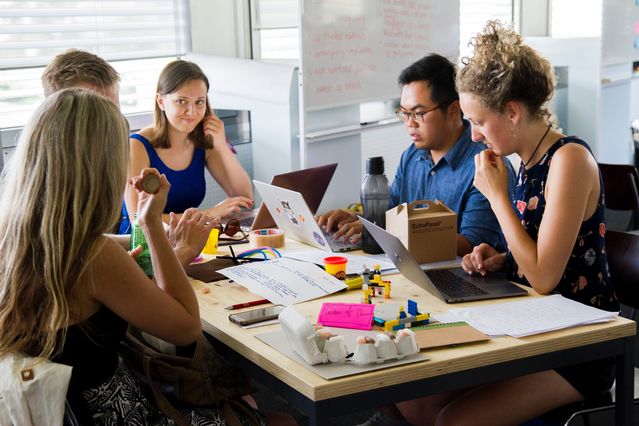Teamwork
Finding Optimal Solitude in an Age of Collaboration
Studies show that time to work on your own is as important as collaboration.
Posted December 27, 2017

To create and do your best work, how do you intentionally shape time for solitude? And how intentionally do you pursue optimal collaboration?
Workplace trends have encouraged collaboration while devaluing if not stigmatizing people who are alone. Yet, anecdotal research and more recent studies point to the benefits of both collaboration and solitude to boost productivity, creativity, and well-being.
If you are an entrepreneur, creative, or anyone who wants to excel and create your best work, you've likely felt the tension between being productive in the company of others and needing healthy alone time.
But there's a challenge: We can spend years in the company of other people but not experience real collaboration, and we can spend hours or days alone and not experience optimal solitude.The challenge is to know what makes for optimal collaboration and what makes for optimal solitude.
I know these challenges well. I run a business with a team, work with a variety of clients, and have built an international community and reputation for helping brands build communities. I thrive on optimal collaboration. But I also am introverted and relish time to create and think alone. A year in advance, I schedule 3-4 days off each month as deep dive retreats - time mostly for me to be in productive solitude.
The research I've assimilated and interviews I've conducted illuminate how to cultivate both collaboration and solitude.
See-Saw Trends in the Workplace
Let’s put the topic of solitude versus collaboration into a cultural context.
In 1980, Christine Congdon, Donna Flynn, and Melanie Redman of Steelcase conducted studies on what American employees wanted in the workplace. More than 50% of employees said they needed more space for direct concentration. As Congdon notes, in direct response throughout the 90s, companies advanced the trend of "cubicle nation" - as Pamela Slim dubbed the workplace at the time. By the late '90s, the trend reversed: more than 50% said they needed more access to co-workers, and 40% wanted more interaction. For the past 15 years, American workplaces have pushed the open work space culture where all workers see each other, run into each other, drop in on each other.
You can predict the effects.
According to one informal survey, 58% of high-performing employees (HPEs) say they need more quiet spaces for problem-solving – and the majority of them now find their workplaces noisy and distracting.
Another recent comprehensive study looked at the experiences of 40,000 workers in 300 U.S. offices. Jungsoo Kim and Richard DeDear, the study's authors, are professors at the University of Sydney's Department of Architecture, Design, & Planning. The results? Overwhelmingly, the benefits of people being close to each other did not outweigh the negative side effects of losing privacy and being distracted.
The most optimal workplaces allow for both collaboration and solitude.
When Do You Need to Collaborate?
Collaboration differs from being in the company of others or being in accountability circles. Choreographer Twyla Tharp has worked with the likes of Billy Joel, Bob Dylan, Elvis Costello, and sometimes whole communities. In her book The Collaborative Habit, she writes that the best collaboration involves "a clearly stated and consciously shared purpose..."
In a round table conversation with author, entrepreneur and business consultant Pamela Slim and with entrepreneur, author, and teacher Leo Babauta, certain patterns emerged for when and why collaboration is essential.
Pam left her corporate job in 1996 and launched her own online endeavors in 2005 at Escape From Cubicle Nation. In 2005, Leo started making radical changes in his personal lifestyle - diet, exercise, and more - and started his online endeavor at ZenHabits.net - which has amassed over a million devoted readers.
For both of them, a pattern emerged: When they made fundamental changes in their personal and professional lives, they sought collaboration with others.
During big transitions or big hairy projects, optimal collaboration offers support, accountability, and resourcefulness.
They collaborated with other people to stay accountable during big change. Slim built important mentor relationships, peer networks, and collaborative efforts to advance her own business's early organizational and human resources projects.
But they each also grew personally by collaborating with their respective reading communities and audiences. Leo describes that he in essence co-collaborated with his reading community, which in turn taught him about himself and fed his ideas about habit formation.
Ample research now points to how collaboration primes creativity and innovation. The most influential and beneficial ideas emerge not from a lone creative genius (call it the Michelangelo or Steve Jobs myth) but instead from the confluence and unpredictable combination of ideas from more than one person. Collaboration between two or more people fuels each person's association of ideas. The power of random association to fuel creativity is detailed in psychologist Dean Keith Simonton's book Scientific Genius.
These are among the many reasons that my team and community abides by the principle that "Do It Together Beats Do It Yourself" or DIT Beats DIY.
The Entrepreneur's Need For Solitude
That said, in this collaborative climate, entrepreneurs and creatives can forget about the utter need for solitude. If you work at a brick and mortar organization, you might be thinking about how much solitude you need in order to advance your ideas, whether it’s in the company you work for or your own side gig and what true collaboration looks like in your workplace.
If you’re working as an entrepreneur or in your own business, how are you making time for solitude to do the deep dive work on your business and not just in your business where you’re checking off your to-do lists? For entrepreneurs, creatives, remote workers, and solo-preneurs who often shape their own work space and time, these questions are trickier. They require more self-knowledge, self-awareness, self-efficacy, and self-regulation.
These questions bring us full circle to the cultural challenges of finding solitude in an age that champions collaboration. The American work force favors the gregarious, outgoing personality. This culture is detailed in the book Quiet by lawyer-turned-leader of the Quiet Revolution Susan Cain. Cain details how introverts - people who are more inwardly drawn and tend to enjoy being alone - contribute value to our culture differently. In her New York Times op-ed "The Rise of the New Groupthink," she argues that "solitude is a catalyst to innovation."
Raymond M. Kethledge and Mike Erwin describe the need for leaders to cultivate what they call productive solitude. Solitude, they argue in the book Lead Yourself First: Inspiring Leadership Through Solitude (Bloomsbury), is "purposeful and that involves working your mind through a particular problem." It also catalyzes self-awareness. As business consultant Jim Collins notes in the foreword, "If leadership begins not with what you do but who you are, then when and how do you escape the noise to find your purpose and summon the strength to pursue it?" Babauta agrees that it's in these moments - often fleeting while walking in nature or running down the road - that we are able to sort through the distractions and know what we really think.
Babauta reflects that most of us do not shape our time and activities intentionally toward collaboration or solitude - in part because of the technology we use that mish-mashes the two superficially. That is, we might be physically alone yet digitally connected to people around the world via our smart phone. And yet in such cases we're neither collaborating or in solitude optimally.
A new study out of SUNY Buffalo supports Cain's, Ketheridge and Erwin's, and Babauta's claims. In short, the psychologists conclude that being unsociable under certain conditions promotes creativity.
The conditions:
Choose solitude. When it's voluntary, it's beneficial.
Choose company. You should still be able to access and interact with other people when you're ready.
I would add that if you practice designated blocks of solitude, you can build the solitude habit. That requires being intentional. Give yourself a voluntary project to work on or something, to create something, or a problem or challenge to work through.
In solitude, your mind still needs something outward to focus on. It's just not another person.




